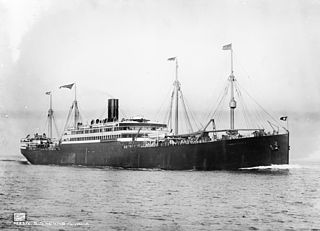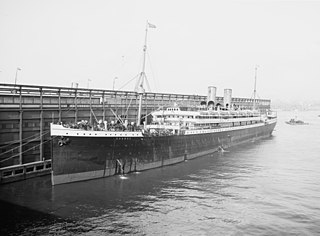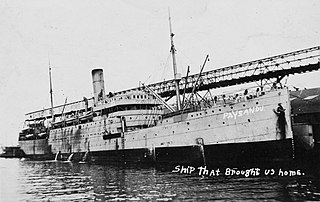Six ships of the United States Navy have borne the name USS Powhatan or USNS Powhatan, named in honor of Powhatan (1550–1618), an Indian chief in tidewater Virginia; the father of Pocahontas.

USS Susquehanna (ID-3016) was a transport for the United States Navy during World War I. She was the second U.S. Navy ship to be named for the Susquehanna River. Before the war she operated at SS Rhein, an ocean liner for North German Lloyd. She was the lead ship of her class of three ocean liners. After the end of World War I, the ship operated briefly in passenger service as SS Susquehanna. Laid up in 1922, Susquehanna was sold to Japanese ship breakers in 1928 and scrapped.

SS Kaiser Wilhelm II was a Norddeutscher Lloyd (NDL) Kaiser-class ocean liner. She was launched in 1902 in Stettin, Germany. In the First World War she was laid up in New York from 1914 until 1917, when the US Government seized her and renamed her USS Agamemnon. In 1919 she was decommissioned from the Navy and laid up. In 1927 she was transferred to the United States Army, who renamed her USAT Monticello. She was scrapped in 1940.

USS Freedom (ID-3024) was a cargo and transport ship in the United States Navy in World War I. Originally Wittekind for the North German Lloyd line, the ship also served as USAT Iroquois and USAT Freedom after being seized by the United States in 1917.

The Hamburg-Amerikanische Packetfahrt-Actien-Gesellschaft (HAPAG), known in English as the Hamburg America Line, was a transatlantic shipping enterprise established in Hamburg, in 1847. Among those involved in its development were prominent citizens such as Albert Ballin, Adolph Godeffroy, Ferdinand Laeisz, Carl Woermann, August Bolten, and others, and its main financial backers were Berenberg Bank and H. J. Merck & Co. It soon developed into the largest German, and at times the world's largest, shipping company, serving the market created by German immigration to the United States and later, immigration from Eastern Europe. On 1 September 1970, after 123 years of independent existence, HAPAG merged with the Bremen-based North German Lloyd to form Hapag-Lloyd AG.

USS Pocahontas (SP-3044) was a transport ship for the United States Navy during World War I. She was originally SS Prinzess Irene, a Barbarossa-class ocean liner built in 1899 by AG Vulcan Stettin of Stettin, Germany, for the North German Lloyd line.

SS Vaterland was an ocean liner launched on 3 April 1913 and began service in 1914 for Germany's Hamburg America Line. The ship, second of three running mates and then the largest passenger ship in the world, made her first voyage to New York arriving on 21 May 1914 under the command of a Commodore and four Captains of the German Naval Reserve to celebrations featuring German and American officials at the line's Hoboken facilities.

USS DeKalb (ID-3010) was the German mail ship Prinz Eitel Friedrich that served during the early part of the First World War as an auxiliary cruiser (Hilfkreuzer) in the Imperial German Navy and later after the US entry into the war, as a US Navy troop ship. Post war she returned to civilian service as the US transatlantic liner SS Mount Clay.

USS Hugh L. Scott (AP-43) was a Hugh L. Scott-class transport ship. She was built in 1921 and spent 20 years in merchant service as a passenger and cargo liner. In July 1941 the ship was delivered to the United States Department of War for Army service as the United States Army Transport Hugh L. Scott operating in the Pacific. In August 1942 the ship was transferred to the United States Navy for conversion to an attack transport, served as a troopship in Operation Torch in November 1942, and was sunk by a U-boat four days later. 59 crewmen and soldiers died during the sinking.

USS Mercury (ID-3012) was a United States Navy transport ship during World War I. She was formerly the Norddeutscher Lloyd liner SS Barbarossa built by Blohm & Voss, Hamburg, Germany, in 1897, and operated by the North German Lloyd Line.

SS Pennsylvania was a transatlantic liner that was launched in Ireland in 1896 and spent most of her career with Hamburg America Line (HAPAG). She was the first of a class of four HAPAG sister ships that were built in the United Kingdom and Germany between 1896 and 1899.

USS Aeolus (ID-3005), sometimes also spelled Æolus, was a United States Navy troopship in World War I. She was formerly the North German Lloyd liner Grosser Kurfürst, also spelled Großer Kurfürst, launched in 1899 that sailed regularly between Bremen and New York. At the outset of World War I the ship was interned by the United States and, when the US entered the war in 1917, was seized and converted to a troop transport.

RMS Empress of Scotland, originally SS Kaiserin Auguste Victoria, was an ocean liner built in 1905–1906 by Vulcan AG shipyard in Stettin for the Hamburg America Line. The ship regularly sailed between Hamburg and New York City until the outbreak of war in Europe in 1914. At the end of hostilities, re-flagged as USS Kaiserin Auguste Victoria, she transported American troops from Europe to the United States. For a brief time Cunard sailed the re-flagged ship between Liverpool and New York.

SS Finland was an American-flagged ocean liner built in 1902 for the Red Star Line. During World War I she served as a transport for the United States Navy named USS Finland (ID-4543). Before her Navy service in 1917, she was also USAT Finland for the United States Army.

SS Prinz Friedrich Wilhelm was an ocean liner for North German Lloyd (NDL) from her launch in 1907 until the end of World War I. After the war, she briefly served as USS Prinz Friedrich Wilhelm (ID-4063) for the United States Navy returning American troops from France. The vessel was first chartered—and later purchased outright—by Canadian Pacific Steamships (CP) and operated under the names Empress of China, Empress of India, Montlaurier, Monteith, and Montnairn. She was scrapped in 1929.

USS Martha Washington (ID‑3019) was a transport for the United States Navy during World War I named for Martha Washington, the first First Lady of the United States. She was originally ocean liner SS Martha Washington for the Austro-American Line before the war. Before and after her Navy service she was the United States Army transport USAT Martha Washington. The liner was sold to the Italian Cosulich Line in 1922. In 1932, when Cosulich was absorbed into Italia Flotte Riunite, the ship was renamed SS Tel Aviv. The ship was scrapped in 1934.

The Barbarossa class was a class of ocean liners of North German Lloyd and the Hamburg America Line of the German Empire. Of the ten ships built between 1896 and 1902, six were built by AG Vulcan Stettin, three were built by Blohm & Voss, and one was built by Schichau-Werke; all were built in Germany. They averaged 11,000 gross register tons (GRT) and featured twin screw propellers driven by quadruple-expansion steam engines.

USS Paysandu (ID-3880) was a troop transport acquired to repatriate U.S. troops from France after World War I.

USS Black Arrow (ID-1534) was a troop transport commissioned in 1919 to assist in the post-World War I repatriation of U.S. troops from France. Black Arrow was originally SS Rhaetia, a passenger-cargo ship built in Germany in 1904–05 for the Hamburg-America Line. From 1905 to 1914, Rhaetia operated primarily between Hamburg, Germany and South America, though she was also intermittently employed as an immigrant ship to the United States. With the outbreak of World War I in August 1914, Rhaetia was interned in Philadelphia.

SS Bulgaria was a passenger-cargo steamship built in 1898 for the Hamburg American Line ("Hapag"). During World War I, she operated as a United States Army animal and cargo ship under the names USAT Hercules and USAT Philippines, and after the war was converted into the troop transport USS Philippines (ID-1677).




















